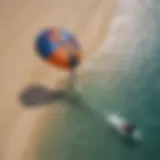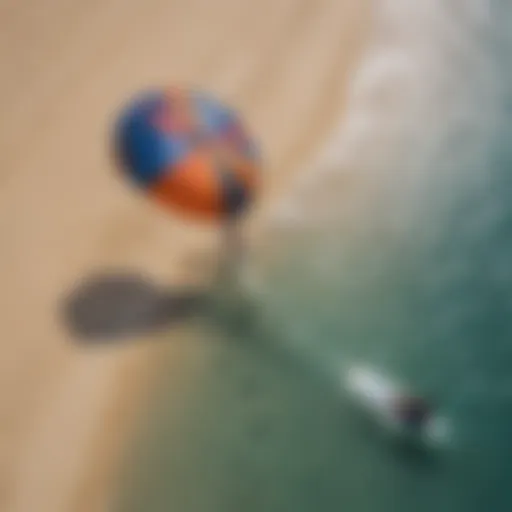Understanding Flotation Vests in Kitesurfing
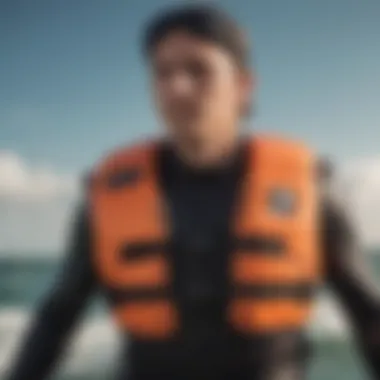

Intro
Flotation vests hold a pivotal role in kitesurfing. Their function goes beyond mere aesthetics; they significantly enhance safety and performance on the water. Understanding flotation vests requires a closer look at their design specifications, the types available, and their suitability for various skill levels. It is crucial for kitesurfers and kiteboarders to make informed decisions regarding the use of flotation vests. This article seeks to elaborate on these aspects, guiding readers through the essential details necessary for a safe kiting experience.
Equipment Reviews
The landscape of kitesurfing equipment is constantly evolving. Flotation vests are no exception. Their purpose extends to providing safety and facilitating a better performance in kitesurfing. Below, we will examine their features, types, and relevant aspects to consider when selecting a flotation vest.
Flotation Vest Design and Features
When discussing flotation vests, various design specifications are essential. Key features include:
- Material: Vests are commonly made from durable, lightweight fabrics. Materials such as neoprene are popular for their flexibility and buoyancy.
- Buoyancy: The level of buoyancy a vest provides is critical. Different models offer varying flotation levels, appealing to different skill sets.
- Fit and Comfort: Proper fitting is vital for safety. Vests should be snug enough to stay in place yet comfortable enough to allow free movement.
Types of Flotation Vests
Flotation vests vary significantly in design and application.
- Competition Vests: Designed for high-performance kitesurfers, these vests prioritize mobility and minimal bulk.
- Recreational Vests: Suitable for beginners and casual riders, these typically offer higher buoyancy and enhanced safety features.
- Hybrid Vests: Combining elements from both competition and recreational vests, hybrid options cater to intermediate riders looking for a balance between safety and performance.
Suitability for Different Skill Levels
Choosing the right vest depending on your skills can affect your kitesurfing experience.
- Beginners should opt for vests with higher flotation and stability. This instills confidence while learning the basics.
- Intermediate riders may benefit from hybrid models that support performance without sacrificing safety.
- Advanced kitesurfers can select competition vests for increased mobility and reduced weight.
Maintenance Practices
Maintaining your flotation vest enhances its durability and effectiveness. Regular checks ensure safety and performance. Here are some maintenance tips:
- Rinse with Fresh Water: After every session, rinse the vest in fresh water to remove salt or sand.
- Dry Properly: Air dry the vest away from direct sunlight to prevent material breakdown.
- Check for Damage: Regularly inspect for tears, frays, or wear to ensure it remains functional.
"Understanding your equipment, including flotation vests, is essential for a safer and more enjoyable kitesurfing experience."
End
Flotation vests play an indispensable role in kitesurfing. By understanding their design, types, and maintenance, riders can ensure safety while enhancing performance. The selection process should consider individual skill levels, preferences, and planned activities on the water. Proper education and maintenance lead to better safety practices and, ultimately, a more enjoyable experience in kitesurfing.
Preface to Flotation Vests
Flotation vests play a crucial role in the realm of kitesurfing and kiteboarding. Safety is paramount when engaging in extreme sports, where water conditions can change rapidly and unexpectedly. A flotation vest not only aids in buoyancy but also enhances confidence, allowing athletes to focus on their performance instead of worrying about potential hazards in the water.
Definition and Purpose
Flotation vests are designed as personal flotation devices that offer support and buoyancy to users in aquatic environments. Their primary purpose is to keep individuals afloat in water, particularly in scenarios where swimming may be difficult or impossible. In kitesurfing, where riders can face strong winds, unexpected falls, and turbulent water, wearing a flotation vest becomes essential. The vest aids in maintaining an upright position in the water, facilitating easier recovery after falls or mishaps.
Additionally, flotation vests often include features like impact protection and pockets for essentials, making them versatile for various water activities. Ultimately, the presence of a flotation vest can mean the difference between safety and danger during aquatic pursuits.
Historical Context
The use of flotation devices dates back centuries, tracing roots to ancient maritime practices aimed at ensuring safety during sea travel. However, the incorporation of flotation vests specifically for sports like kitesurfing emerged more recently. As kitesurfing gained popularity in the late 20th century, the need for protective gear became clear.
Early flotation vests were relatively simple, fashioned from basic foam materials. Over time, as the sport evolved and technology advanced, flotation vest design began to prioritize not just buoyancy but also comfort, flexibility, and performance safety. Modern flotation vests now utilize advanced materials that can withstand the rigors of extreme sports while offering the necessary support. The historical evolution of flotation vests reflects the ongoing commitment to improving safety standards in kitesurfing, contributing to a more secure experience for riders.
The Importance of Safety in Kitesurfing
In the realm of kitesurfing, safety should be a foremost consideration for athletes. Engaging in an extreme sport such as this contains inherent risks. It is crucial to address these dangers while enjoying the thrills of the experience. The necessity for safety measures stems from a clear understanding of potential hazards involved in kitesurfing. This section delves into the importance of safety, focusing on water risks, and highlights how flotation vests serve as a critical component of safety protocols.
Understanding Water Risks
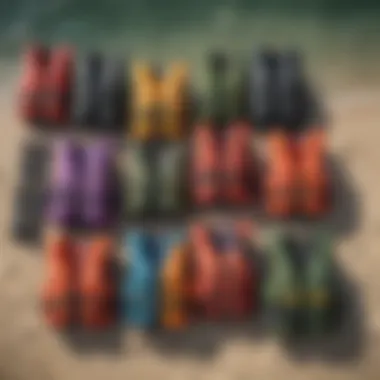

Water sports often pose unique complications. Kitesurfing takes place in open waters, where conditions can change rapidly. Factors such as wind speed, wave height, and water currents are just a few elements that can impact the safety of participants.
The following risks should be acknowledged:
- Drowning: The most significant risk, which can occur due to sudden accidents or equipment failure.
- Hypothermia: Cold water temperatures can lead to body heat loss, impairing a person's ability to swim or respond appropriately.
- Collisions: Riders risk colliding with obstacles, other kitesurfers, or boats, which can result in serious injuries.
- Dehydration and Fatigue: Extended time in the sun and wind can lead to physical exhaustion and dehydration.
Recognizing these water risks is paramount. Awareness of potential dangers enables kitesurfers to prepare adequately, ensuring their safety and the safety of others on the water.
Flotation Vests as a Safety Measure
Flotation vests play an essential role in promoting safety for kitesurfers. Their design aims to keep individuals buoyant, increasing their chances of survival in distressing situations. A flotation vest is more than a mere accessory; it functions as a lifeline that can give riders confidence while they navigate waters.
Here are several reasons why flotation vests are important in kitesurfing:
- Enhanced Buoyancy: Flotation vests provide additional buoyancy, which is crucial for maintaining safety if a rider falls off their board.
- Impact Protection: Some flotation vests are designed to cushion impacts, reducing the risk of injury from falls or collisions.
- Visibility: Bright and reflective color options increase visibility in the water, making it easier for rescue teams to locate a rider in distress.
- Comfort in Movement: Modern flotation vest designs prioritize comfort, allowing riders to move freely while still providing essential buoyancy.
"Wearing a flotation vest can be the difference between a close call and a tragic accident. Safety should be non-negotiable in kitesurfing."
Types of Flotation Vests Available
Understanding the different types of flotation vests is crucial for kitesurfers looking to enhance their safety and performance on the water. Each type serves specific needs and contexts in kitesurfing, making it vital to choose the right one. The following sections will explore the unique features, benefits, and considerations associated with standard buoyancy vests, impact vests, and inflatable vests.
Standard Buoyancy Vests
Standard buoyancy vests are often the first choice for many beginners and intermediate kitesurfers. These vests are designed to provide adequate flotation, helping the user stay above water, which is essential in case of unexpected falls or injuries.
- Buoyancy Levels: These vests typically offer a minimum buoyancy level that can keep a person afloat easily. It is important to check the rated buoyancy when selecting a vest.
- Material: Most standard vests are made from durable foam that is lightweight yet functional. The material can withstand water exposure, making it suitable for prolonged use.
- Design: The design often includes a snug fit to prevent the vest from moving excessively while kitesurfing. Many vests feature adjustable straps to enhance the fit.
Despite their advantages, standard buoyancy vests can restrict movement when compared to other options. Therefore, if you are contemplating fast maneuvers or jumps, you should explore other types.
Impact Vests
Impact vests provide more than just flotation; they include padding intended to absorb shock during falls, addressing the safety needs of more advanced kitesurfers. These vests are recommended for those who engage in tricks or high-speed riding.
- Shock Absorption: The padding in impact vests is concentrated on the sides and back. This design mitigates the impact when hitting the water or landing from jumps.
- Fit: They tend to have a tighter fit, less bulky padding, and a sleek design, allowing for better freedom of movement.
- Protection vs. Buoyancy: While these vests provide some buoyancy, they may not float as well as standard buoyancy vests. Users must be cautious about their safety in high-risk situations.
Impact vests are a valuable investment for those wanting to push their limits in kitesurfing. They enhance safety while allowing for dynamic movement.
Inflatable Vests
Inflatable vests are designed for those who favor a lightweight option with adjustable buoyancy. They typically come with an integrated chamber that can be inflated on demand, providing a unique blend of comfort and safety.
- Compact Design: When not inflated, these vests are less cumbersome than their counterparts, making them easier to carry and manage.
- Adjustable Buoyancy: Users can control the level of buoyancy based on their skill level or environmental conditions. This feature can be particularly beneficial in varying water conditions.
- Use in Higher Risk Conditions: They are ideal for experienced kitesurfers navigating more turbulent waters.
Nevertheless, inflatable vests require regular maintenance, including checking for leaks or ensuring the inflation mechanism works properly.
Design and Features of Flotation Vests
The design and features of flotation vests play a crucial role in their functionality and effectiveness for kitesurfers. Understanding these aspects is essential for ensuring both safety and comfort while engaging in this high-adrenaline sport. Flotation vests must be constructed to withstand harsh conditions while providing buoyancy and mobility. The right design can offer greater confidence in unpredictable water environments.
Material Considerations
The choice of material in flotation vests greatly affects their performance. Common materials include neoprene, nylon, and polyester. Neoprene is popular for its insulation properties, providing warmth in cooler waters. Nylon offers durability but may lack some flexibility. Polyester is often used for vests that require lightweight designs. When selecting a vest, one should look for a good balance between warmth, flexibility, and durability.
- Breathability: Look for materials that allow moisture to escape, minimizing sweat build-up.
- Quick-Drying: It is important that the vest dries quickly post-session to prevent discomfort or chafing.
- Scratch Resistance: Consider how the material holds up against abrasions from constant use.
Fit and Comfort
Fit is one of the key aspects of flotation vests. A well-fitting vest is essential not only for comfort but also for safety. Ill-fitting vests can shift during kitesurfing, hindering paddling and movement.
- Snug but Not Restrictive: The vest should feel snug around the torso but still allow for easy arm movements.
- Adjustable Straps: Look for vests that feature adjustable straps or side belts for a customizable fit.
- Sizes and Shapes: Be mindful that flotation vests come in various sizes and cuts. Consider your body shape when selecting a vest.
Attachment Points and Pockets
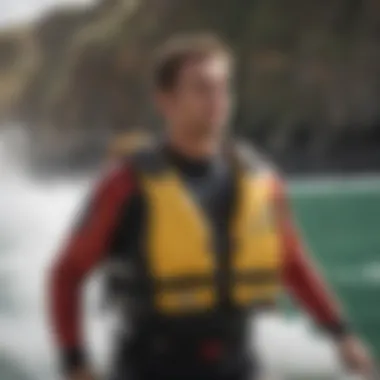

The presence of well-placed attachment points and pockets can significantly enhance a vesst's usability. Many kitesurfing vests include specific features for convenient storage and gear connectivity.
- D-Rings: Useful for attaching safety gear like leashes or quick-release systems.
- Pockets: Some vests are equipped with waterproof pockets for storing personal items like keys or phones.
- Easy Access: Ensure that any pockets or attachment points do not interfere with mobility.
"Choosing a flotation vest that combines functionality and comfort is key. It enhances your performance, enabling you to focus more on riding the waves."
In summary, the design and features of flotation vests should not be overlooked by kitesurfers. Proper material choice, fit, and additional functionalities like pockets and attachment points can significantly impact safety and enjoyment on the water.
Choosing the Right Flotation Vest
Selecting the appropriate flotation vest is crucial for maximizing safety and performance in kitesurfing. Kitesurfers are exposed to the unpredictable nature of water and wind. Thus, choosing a vest that fits specific needs can significantly influence the experience. A well-chosen vest provides buoyancy while allowing freedom of movement. This section focuses on how various factors affect the selection process, enabling readers to make informed choices.
Skill Level Considerations
The skill level of a kitesurfer plays a significant role in choosing the right flotation vest. For beginners, a standard buoyancy vest may be most suitable. These vests offer necessary floatation without overwhelming features that can be distracting. Beginners should focus on comfort and ease of use as they learn the fundamentals. Thus, a vest with basic features aids in their learning process.
Conversely, advanced riders might prefer impact vests. These are designed to provide additional protection during high-impact activities, such as tricks and jumps. Experienced kitesurfers understand their requirements well, often opting for vests that offer a blend of buoyancy and protection from falls. Ultimately, recognizing one's skill level informs the choice of flotation vest, enhancing safety and overall enjoyment.
Weight and Size Compatibility
Weight and size compatibility is another crucial aspect when selecting a flotation vest. Proper fit is essential for both comfort and functionality. A vest that is too loose can impede movement, while one that is too tight can restrict blood circulation.
Most brands provide size guides that include measurements for chest, waist, and overall body size. Kitesurfers should take the time to measure themselves accurately. Trying on vests before purchase is ideal, if possible, as each brand may fit differently.
It's also important to be aware of weight limits. Each vest has a range of buoyancy based on the wearer’s weight. A vest that suits one individual might not work for another. Therefore, understanding one’s weight and body type ensures the vest performs as intended in water, providing not just safety but also confidence in kitesurfing.
Understanding Regulations
Kitesurfing is subject to various regulations, which can sometimes dictate the type of flotation vest required. Different locations may have specific laws regarding safety equipment. For instance, some countries mandate the use of certain vests for specific activities.
Kitesurfers should educate themselves on local regulations to ensure compliance. This can involve checking with local kitesurfing organizations or accessing resources such as the International Kiteboarding Association. Safety should never be compromised for lack of knowledge. Adhering to regulations not only keeps the kitesurfer safe but also promotes a responsible image within the sport.
Proper knowledge about flotation vests and compliance with regulations can enhance safety while kitesurfing.
Maintenance and Care of Flotation Vests
Flotation vests are vital for kitesurfing safety. However, their effectiveness can diminish over time due to improper care. Maintaining these vests is crucial not only for safety but also for longevity. Proper maintenance can prevent wear and tear, ensuring that the vest performs effectively when needed. Furthermore, understanding the care protocols can help kitesurfers make educated choices about their equipment.
Cleaning Protocols
Regular cleaning is essential for flotation vests. Saltwater, sand, and sun exposure can deteriorate the materials. To clean a flotation vest, follow these general steps:
- Rinse: Always rinse the vest with fresh water after each use. This removes salt and sand, preventing buildup.
- Use Mild Soap: If there are stains or dirt, use a mild soap. Avoid strong detergents as they can harm the vest’s material.
- Hand Wash: Gently scrub the vest by hand using a soft sponge or cloth. Pay attention to seams and straps, which can trap dirt.
- Air Dry: Never machine dry the vest. Instead, lay it flat or hang it to dry in a shaded area. Direct sunlight can lead to color fading and material breakdown.
"A well-maintained flotation vest enhances safety during kitesurfing and extends its service life."
This cleaning routine should be done periodically, especially after extensive use or exposure to harsh conditions. Proper cleaning not only prolongs the life of the flotation vest but also keeps it looking good.
Storage Recommendations
Storing the flotation vest correctly is just as important as cleaning it. Proper storage can prevent deformation or damage. Here are some guidelines for storage:
- Cool, Dry Place: Keep the vest in a cool and dry environment. Excessive heat and humidity can weaken the materials.
- Avoid Folding: Instead of folding, hang the vest on a hanger. This reduces creases and helps maintain its shape.
- Protection from Pests: Ensure that the storage area is free from pests. Mice or insects can chew on materials, compromising the vest’s integrity.
- Storage Bag: If possible, use a protective bag. This shields the vest from dust and minimizes exposure to sunlight during storage.
The combination of proper cleaning and mindful storage contributes greatly to the longevity and reliability of flotation vests. Through careful maintenance, kitesurfers can ensure that their gear remains effective and safe.
Personal Experiences and Testimonials
In kitesurfing, personal experiences and testimonials play a key role in understanding the efficiency and reliability of flotation vests. These narratives offer valuable insights into the real-world application of the vests, reflecting how they perform under various conditions. They also highlight the perspectives of both novice and seasoned riders, serving as a guiding beacon for those contemplating their own safety gear.
The importance of collecting and sharing these stories cannot be understated. For beginners, they provide reassurance about their choices and help alleviate the fear associated with water sports. Meanwhile, advanced riders can offer wisdom based on first-hand knowledge, leading to more informed decisions about equipment. These experiences not only foster a supportive community but also enhance individual understanding of flotation vests.
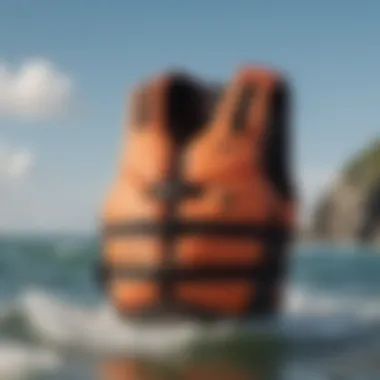

From product safety features to performance under stress, testimonials encapsulate the essence of what it is like to trust your life vest in unpredictable water conditions. The cumulative experiences from a range of users can shape perceptions and lead to improvements in vest technology itself.
Additionally, personal stories often contain practical advice. They may discuss how different styles and fits work for various body types and how to effectively assist in more challenging situations. This makes the narrative rich and relevant for a wide audience.
Stories of both success and caution can change the way newcomers approach kitesurfing, paving the path to a safer experience.
Stories from Beginner Kitesurfers
Beginners often face numerous challenges as they navigate the waters for the first time. The stories shared by these novice kitesurfers can provide various insights into the initial interactions with flotation vests. Many beginners focus on how these vests helped them stay buoyant during first attempts at riding the waves.
One common theme in these narratives is the confidence gain. For example, many beginner kitesurfers mention how wearing a flotation vest made them feel more secure, thus encouraging them to push their boundaries. In one instance, a beginner recounted their first time on the water, emphasizing how the vest kept them afloat after a fall. This experience allowed them to regain control instead of panicking, ultimately enhancing their overall learning process.
Other stories describe the importance of fit and comfort. Many novices express that they initially struggled to find the right size, leading to discomfort that distracted them from their focus. These experiences often urge newcomers to prioritize proper fitting to enhance their learning journey.
Insights from Advanced Riders
For advanced riders, experiences with flotation vests tell a different story. Their testimonials often revolve around the balance of safety, performance, and innovation in designs. These seasoned athletes understand the dynamics of the sport, and their feedback can highlight the nuances that many beginners might overlook.
One advanced rider shared how, during intense kitesurfing sessions, their choice of an impact vest significantly added to their capability to withstand sudden falls. This rider pointed out the importance of having vests that supported their movements without restricting them. The blend of safety and functionality has become a deciding factor in their gear choices.
Moreover, advanced riders might reflect on the evolution of flotation vests over the years. They may discuss how new technologies, like smart sensors, have potentially improved safety, showing that they value progress in that aspect. Their testimonials often serve to bridge the gap between tradition and cutting-edge technology, demonstrating how innovations can either enhance the thrill of the sport or add another layer of safety.
In summary, personal experiences and testimonials enrich the understanding of flotation vests in kitesurfing. They help connect various levels of users through shared lessons and insights, making the selection process for flotation vests less daunting and more informed.
Future Trends in Flotation Vest Technology
The realm of kitesurfing is continuously evolving, and so are the flotation vests that support the sport. As technology grows, the integration of advanced materials and features within flotation vests becomes essential. This evolution not only enhances safety but also improves the overall performance of riders. Understanding these trends is crucial for kitesurfers and enthusiasts, providing insights into how to better protect themselves while enjoying the sport.
Innovations in Materials
Modern flotation vests are increasingly made from innovative materials that significantly enhance buoyancy and comfort. Manufacturers are exploring lightweight and durable fabrics that do not compromise safety. These fabrics are designed to be water-resistant and fast-drying, addressing one of the common inconveniences faced by kitesurfers.
Additionally, materials such as neoprene are being used not only for their buoyant properties but also for their flexibility and thermal insulation. Some vests incorporate closed-cell foam, which provides additional buoyancy while limiting water absorption. This is crucial during fall or immersion in water, as the vest remains effective without becoming heavy.
- Lightweight Design: Innovations focus on reducing weight without sacrificing functionality.
- Thermal Comfort: Materials that retain warmth while allowing for mobility are increasingly favored.
- Durable Fabrics: Resistance to abrasions is important considering the rough conditions in which kitesurfing takes place.
Smart Vests and Safety Features
The concept of smart flotation vests is gaining traction within the kitesurfing community. These vests are equipped with technology that integrates safety features enhancing user experience. For example, vests may now include built-in GPS tracking systems, providing real-time location data which can be invaluable during emergencies.
Other noteworthy features include:
- Automatic Inflatable Mechanisms: Some vests deploy if the rider enters the water forcefully, providing instant buoyancy.
- Integrated Communication Devices: Riders can maintain contact with others, enhancing safety during rides in isolated areas.
- Health Monitoring Sensors: These sensors can track vital signs and send alerts to emergency contacts in case of irregularities.
"Emerging technologies in flotation vests represent a paradigm shift. They enhance safety while pushing the boundaries of performance," notes an industry expert.
Exploring innovations can help in making informed purchasing decisions that align with current advancements and personal kitesurfing goals.
Ending
The conclusion serves as a vital component in this article, encapsulating the core themes surrounding flotation vests in kitesurfing. It emphasizes how these flotation aids are integral not only to safety but also to enhancing overall performance in water sports. In summarizing the key aspects discussed earlier, the conclusion offers clarity on the practical benefits of flotation vests, which can often be overlooked.
Recap of Key Points
The discussion has taken us through various dimensions of flotation vests, from their historical significance to modern advancements in design. The key points can be recapped as follows:
- Safety Importance: Flotation vests minimize drowning risk and provide crucial support in emergencies.
- Types of Vests: Different vests like standard buoyancy, impact, and inflatable vests serve distinct purposes catering to varying rider needs.
- Material and Comfort: Design features impact both the user experience and safety. Proper fit and comfort are paramount for effective use.
- Regulatory Compliance: Understanding local regulations can ensure that kitesurfers are using the right gear.
- Maintenance Practices: Regular cleaning and proper storage prolong the lifespan of flotation vests and ensure they are reliable when needed most.
The Role of Flotation Vests in Improving Safety
Flotation vests play a crucial role in kitesurfing safety, acting as a lifeline for those engaged in this exhilarating sport. Their primary function goes beyond simple buoyancy; they enhance confidence and stability on the water. When riders feel secure in their gear, they can focus more on mastering their skills, which leads to a more enjoyable experience.
"The presence of flotation vests can convert a potentially hazardous situation into a manageable one, allowing for safer enjoyment of the sport."
Moreover, proper use of flotation vests can significantly decrease the likelihood of serious injuries. The designs nowadays incorporate various features such as impact resistance and additional support in key areas, making them more than just safety devices.
In summary, understanding the nuances of flotation vests can empower kitesurfers to make informed choices that align with their skills and safety needs, ultimately transforming their experience on the water.
